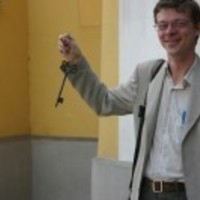
Imre Takács
Related Authors
Zsombor Jekely
Museum of Applied Arts, Budapest
Ileana Burnichioiu
Universitatea "1 Decembrie 1918" Alba Iulia
József Laszlovszky
Central European University
Mária Tóth
Institute for Geological and Geochemical Research, Research Centre for Astronomy and Earth Sciences, Hungarian Academy of Sciences
Viktória Mozgai
Institute for Geological and Geochemical Research, Research Centre for Astronomy and Earth Sciences, Hungarian Academy of Sciences
Bernadett Bajnóczi
Institute for Geological and Geochemical Research, Research Centre for Astronomy and Earth Sciences, Hungarian Academy of Sciences
Béla Zsolt Szakács
Pázmány Péter Catholic University










Uploads
Papers by Imre Takács
and the Royal Palace of Esztergom from King Béla III’s era. All of the four examined objects (two fragments from the Porta
speciosa and two throne arm-rests) have incrustations with red limestone basement and other colourful stone pieces. As red
limestone is a well-known material in Hungarian art history with a rich historiography, the paper focuses on the findings of
the analyses of other stone materials of the incrustations. The research contains several non-destructive analytical methods,
such as relative humidity measurement, macroscopic and microscopic photography and X-ray fluorescence with lithologic
description. Besides the comparative analysis of the stone materials, archive documents, the current state and the impacts of
subsequent restorations of the four stone artefacts were also studied
(1205–1235) and a victim of assassination in 1213, were discovered during the excavations carried out in the Cistercian church of
Pilis between 1967 and 1982. Her tomb was found along the central axis of the church, in the crossing. The present study, which
includes the complete catalogue of the known fragments, attempts to establish the typology, iconography, and stylistic context of
the artwork. New reconstructions are proposed for the two short sides of the sarcophagus-shaped tomb, which each bore distinct
forms: one contained a wide, shallow niche, while the other depicted two standing figures under a double arcade. The figural ornaments
on the sides of the tomb and the gisant with angels on the lid occupy an important place in the history of funerary art. In
fact, the tomb displays one of the first examples of this type of decoration. The seated figures on the side relief probably represent
the choir of saints in heaven, who provided companionship for the soul of the deceased queen. Gertrude herself is represented
not only on top of the tomb, but also appears as a donor in one of the reliefs.
Stylistic analysis of the figures proves that their master came from the workshop responsible for the Last Judgment and Callixtus
portals of the cathedral of Reims. He must have left the workshop around 1220, before the portals were completed and
installed in the façade of the northern transept. At about this time, Villard de Honnecourt also embarked on his travels that took
him from Reims to Hungary. The style of Gertrude’s tomb bears similarities to the Villard’s drawings, even if we do not wish to
attribute the sculptures to him. A team of masons from Reims also arrived in Pannonhalma during this time frame and worked
on the abbey church there. Their most important work in Pannonhalma is the southern portal of the new church, the Porta Speciosa.
The complicated nature of these construction histories reminds us of the need for caution when attributing one work of art
to one person.
Both Gertrude’s tomb and the Porta Speciosa are prime examples of the cultural and artistic period that began in the late
12th century, when the Kingdom of Hungary was a leader in the region in the reception of French Gothic.
such as its original sanctuary, which was demolished soon after completion and replaced by another. Also discussed are a
number of carvings used in a secondary or tertiary setting, as spolia, originally made around 1200 or at the beginning of the 13th
century, and then removed from their original context. Fragments of chevron-decorated carvings can be arranged along an arch
that, because of its size, can only be identified with the transverse arch of the original apse of the sanctuary. The transverse arch
on the face of the Gyulafehérvár apse, built around 1200, was – as far as we know today – the largest structural element in Central
Europe decorated with a “Norman” chevron ornament. From the exterior decoration of the original apse a surprisingly large
number of richly decorated details still survive. The entablature high on top of the polygonal apse of the present-day sanctuary
is richly decorated with figures and other motifs in high relief. The placement of these carvings is clearly secondary. Obviously
pieces from the entablature of the 12th-century apse were re-used in the 13th-century Gothic apse (and later when it was rebuilt in
the 18th century). The thematic focus of the Gyulafehérvár cornice also relates to the figural decoration of the capitals inside the
sanctuary. In addition to this series, about a dozen or so other figural carvings from this same period adorn the church. The two
reliefs depicting St. Michael, both found in secondary placement high on the outside wall of the sanctuary, are the most important
of these carvings.
Books by Imre Takács
and the Royal Palace of Esztergom from King Béla III’s era. All of the four examined objects (two fragments from the Porta
speciosa and two throne arm-rests) have incrustations with red limestone basement and other colourful stone pieces. As red
limestone is a well-known material in Hungarian art history with a rich historiography, the paper focuses on the findings of
the analyses of other stone materials of the incrustations. The research contains several non-destructive analytical methods,
such as relative humidity measurement, macroscopic and microscopic photography and X-ray fluorescence with lithologic
description. Besides the comparative analysis of the stone materials, archive documents, the current state and the impacts of
subsequent restorations of the four stone artefacts were also studied
(1205–1235) and a victim of assassination in 1213, were discovered during the excavations carried out in the Cistercian church of
Pilis between 1967 and 1982. Her tomb was found along the central axis of the church, in the crossing. The present study, which
includes the complete catalogue of the known fragments, attempts to establish the typology, iconography, and stylistic context of
the artwork. New reconstructions are proposed for the two short sides of the sarcophagus-shaped tomb, which each bore distinct
forms: one contained a wide, shallow niche, while the other depicted two standing figures under a double arcade. The figural ornaments
on the sides of the tomb and the gisant with angels on the lid occupy an important place in the history of funerary art. In
fact, the tomb displays one of the first examples of this type of decoration. The seated figures on the side relief probably represent
the choir of saints in heaven, who provided companionship for the soul of the deceased queen. Gertrude herself is represented
not only on top of the tomb, but also appears as a donor in one of the reliefs.
Stylistic analysis of the figures proves that their master came from the workshop responsible for the Last Judgment and Callixtus
portals of the cathedral of Reims. He must have left the workshop around 1220, before the portals were completed and
installed in the façade of the northern transept. At about this time, Villard de Honnecourt also embarked on his travels that took
him from Reims to Hungary. The style of Gertrude’s tomb bears similarities to the Villard’s drawings, even if we do not wish to
attribute the sculptures to him. A team of masons from Reims also arrived in Pannonhalma during this time frame and worked
on the abbey church there. Their most important work in Pannonhalma is the southern portal of the new church, the Porta Speciosa.
The complicated nature of these construction histories reminds us of the need for caution when attributing one work of art
to one person.
Both Gertrude’s tomb and the Porta Speciosa are prime examples of the cultural and artistic period that began in the late
12th century, when the Kingdom of Hungary was a leader in the region in the reception of French Gothic.
such as its original sanctuary, which was demolished soon after completion and replaced by another. Also discussed are a
number of carvings used in a secondary or tertiary setting, as spolia, originally made around 1200 or at the beginning of the 13th
century, and then removed from their original context. Fragments of chevron-decorated carvings can be arranged along an arch
that, because of its size, can only be identified with the transverse arch of the original apse of the sanctuary. The transverse arch
on the face of the Gyulafehérvár apse, built around 1200, was – as far as we know today – the largest structural element in Central
Europe decorated with a “Norman” chevron ornament. From the exterior decoration of the original apse a surprisingly large
number of richly decorated details still survive. The entablature high on top of the polygonal apse of the present-day sanctuary
is richly decorated with figures and other motifs in high relief. The placement of these carvings is clearly secondary. Obviously
pieces from the entablature of the 12th-century apse were re-used in the 13th-century Gothic apse (and later when it was rebuilt in
the 18th century). The thematic focus of the Gyulafehérvár cornice also relates to the figural decoration of the capitals inside the
sanctuary. In addition to this series, about a dozen or so other figural carvings from this same period adorn the church. The two
reliefs depicting St. Michael, both found in secondary placement high on the outside wall of the sanctuary, are the most important
of these carvings.